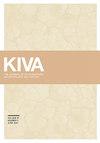Fuelwood Collection and Women’s Work in Ancestral Puebloan Societies on the Colorado Plateau
IF 0.4
0 ARCHAEOLOGY
Kiva-Journal of Southwestern Anthropology and History
Pub Date : 2023-09-27
DOI:10.1080/00231940.2023.2259250
引用次数: 0
Abstract
AbstractAnthropologists have recently paid greater attention to gender and the division of labor in subsistence societies around the world. These studies have included Ancestral Puebloan societies in the United States Southwest, particularly on the Colorado Plateau. Based on ethnographic literature, women in this region have been responsible traditionally for a wide range of domestic activities, including child-rearing, farming, food preparation, cooking, pottery making, basket weaving, and collecting and transporting firewood and water. The present study presents a predictive model for prehistoric cooking energy systems on the Colorado Plateau. This model examines the causal links between environmental variables and fuelwood demand, acquisition, and use. These causal relationships have been delineated in contemporary cross-cultural research as well as studies of high-altitude cooking. Fuelwood collection, transport, and use form the core of women’s workload. This preliminary study serves to predict women’s annual workload based on the relationship between the number of fuelwood collecting trips and the elevation of Ancestral Puebloan settlements.Los antropólogos y arqueólogos han prestado recientemente mayor atención al género y la división del trabajo en las sociedades de subsistencia de todo el mundo. Estos estudios han incluido sociedades ancestrales Puebloan en el suroeste de Estados Unidos, particularmente en la meseta de Colorado. Según la literatura etnográfica, las mujeres de esta región han sido responsables de una amplia gama de actividades domésticas, incluida la crianza de los hijos, la agricultura, la preparación de alimentos, la cocina, la fabricación de cerámica, el tejido de cestas y la recolección y transporte de leña y agua. El presente estudio presenta un modelo explicativo para los sistemas prehistóricos de energía para cocinar en la meseta de Colorado. Este modelo examina los vínculos causales entre la demanda, adquisición y uso de leña basándose en investigaciones interculturales contemporáneas y las exigencias de la cocina a gran altitud.KEYWORDS: Ancestral PuebloColorado Plateauwomenworkloaddivision of laborfuelwoodaltitudecooking time AcknowledgementsI greatly appreciate the support of the following individuals: Melinda Kelly, Ralph J. Hartley, Matt G. Hill, Robert K. Hitchcock, Beth R. Ritter, and Richard L. Taylor. I benefited greatly from the instructive comments of two anonymous reviewers. Special thanks go to Dr. Tom Rocek, Kiva editor, for his diligence, insight, and patience.Disclosure StatementNo potential conflict of interest was reported by the author(s).Notes1 “In areas of low woody biomass, such as some areas of the Southwest, the availability of wood may have been a significant limiting factor on human behavior. For example, Whiting (Citation1939) suggests that, before the introduction of the mule and wagon, the Hopi had to make do with shrubby wood-producing plants, such as greasewood. With the introduction of better transportation, the Hopi can now exploit the more desirable but more distant juniper and piñon wood. Clearly, then, the analysis of patterns of wood use in prehistory has been neglected.” Nelson and LeBlanc Citation1986:213) .2 “The supply of timber and firewood close to the Hopi villages is so very scant as to be almost valueless economically; to secure wood for craft activities and for cooking, expeditions are made at frequent intervals to the Black Mesa forests a day or more distant to the north. An individual makes the expedition alone or else two friends take a wagon and supplies and gather timber together for their households. As the wood closer to the villages is being rapidly used up, expeditions have to go further to the north each year to secure adequate supplies. The principal timbers used are cottonwood, piñon, mountain oak and mountain mahogany … . Wood gathering is an informal activity for the most part, but occasionally formal expeditions are held.” (Beaglehole and Beaglehole Citation1937:88)科罗拉多高原上普韦布洛部落祖先的薪柴收集和妇女工作
摘要近年来,人类学家越来越关注世界各地自给社会中的性别和劳动分工。这些研究包括在美国西南部,特别是在科罗拉多高原的祖先普韦布洛人社会。根据民族志文献,该地区的妇女传统上负责广泛的家庭活动,包括抚养孩子、耕种、准备食物、烹饪、制作陶器、编织篮子,以及收集和运输木柴和水。本研究提出了科罗拉多高原史前烹饪能源系统的预测模型。该模型考察了环境变量与薪材需求、获取和使用之间的因果关系。这些因果关系已经在当代跨文化研究以及高海拔烹饪研究中被描绘出来。木柴的收集、运输和使用构成了妇女工作的核心。这项初步研究的目的是根据收集柴火的次数与普韦布洛人祖居地海拔之间的关系,预测妇女每年的工作量。Los antropólogos y arqueólogos han prestado recientemente mayor atención al - g ···················Estos工作室包括Estados Unidos,特别是科罗拉多州的meseta。Según文学协会etnográfica、墨西哥妇女协会región和其他组织负责国内 材料交换和其他组织的活动,包括农业协会、农业协会、preparación食品协会、墨西哥协会、fabricación协会cerámica、墨西哥协会、recolección协会和危地马拉运输协会leña协会。El presente estudio presente unmodelo explativo para los sistemas prehistóricos de energía para cocinar en la meseta de Colorado。Este modelo examina los vínculos causales entre la demanda, adquisición通过uso de leña basándose en investigaciones interculturales contemporáneas通过las exigencias de la cocina a gran。关键词:古老的普韦布洛,科罗拉多高原,妇女工作量,劳力,木材,海拔,烹饪时间致谢我非常感谢以下个人的支持:Melinda Kelly, Ralph J. Hartley, Matt G. Hill, Robert K. Hitchcock, Beth R. Ritter和Richard L. Taylor。我从两位匿名评论者的指导性评论中受益匪浅。特别感谢Kiva编辑Tom Rocek博士的勤奋、洞察力和耐心。披露声明作者未报告潜在的利益冲突。注1“在木材生物量低的地区,例如西南的一些地区,木材的供应可能是人类行为的一个重要限制因素。例如,怀廷(Citation1939)认为,在引入骡子和马车之前,霍皮人不得不使用灌木状的木材生产植物,如油木。随着更好的交通工具的引入,霍皮人现在可以开采更理想但更远的杜松和piñon木材。显然,对史前木材使用模式的分析被忽视了。”Nelson and LeBlanc引文(1986:213).2“霍皮人村庄附近的木材和木柴供应非常稀少,几乎没有经济价值;为了获得用于工艺活动和烹饪的木材,探险队经常每隔一段时间就到黑台地森林或更遥远的北部去探险。一个人独自探险,或者两个朋友开着一辆马车,一起为他们的家庭收集木材。由于村庄附近的木材正在迅速枯竭,探险队不得不每年向北走得更远,以确保足够的供应。主要使用的木材是棉木,piñon,山橡木和山红木... .在大多数情况下,采集木材是一种非正式的活动,但偶尔也会举行正式的探险活动。(比格尔霍尔和比格尔霍尔引文1937:88)
本文章由计算机程序翻译,如有差异,请以英文原文为准。
求助全文
约1分钟内获得全文
求助全文
来源期刊
CiteScore
0.70
自引率
33.30%
发文量
31

 求助内容:
求助内容: 应助结果提醒方式:
应助结果提醒方式:


